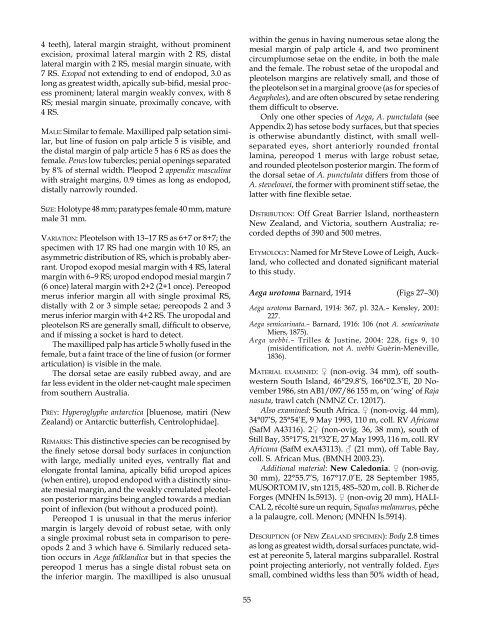The Marine Fauna of New Zealand: Isopoda, Aegidae (Crustacea)
The Marine Fauna of New Zealand: Isopoda, Aegidae (Crustacea)
The Marine Fauna of New Zealand: Isopoda, Aegidae (Crustacea)
Create successful ePaper yourself
Turn your PDF publications into a flip-book with our unique Google optimized e-Paper software.
4 teeth), lateral margin straight, without prominent<br />
excision, proximal lateral margin with 2 RS, distal<br />
lateral margin with 2 RS, mesial margin sinuate, with<br />
7 RS. Exopod not extending to end <strong>of</strong> endopod, 3.0 as<br />
long as greatest width, apically sub-bifid, mesial process<br />
prominent; lateral margin weakly convex, with 8<br />
RS; mesial margin sinuate, proximally concave, with<br />
4 RS.<br />
maLe: Similar to female. Maxilliped palp setation similar,<br />
but line <strong>of</strong> fusion on palp article 5 is visible, and<br />
the distal margin <strong>of</strong> palp article 5 has 6 RS as does the<br />
female. Penes low tubercles; penial openings separated<br />
by 8% <strong>of</strong> sternal width. Pleopod 2 appendix masculina<br />
with straight margins, 0.9 times as long as endopod,<br />
distally narrowly rounded.<br />
size: Holotype 48 mm; paratypes female 40 mm, mature<br />
male 3 mm.<br />
Variation: Pleotelson with 3– 7 RS as 6+7 or 8+7; the<br />
specimen with 7 RS had one margin with 0 RS, an<br />
asymmetric distribution <strong>of</strong> RS, which is probably aberrant.<br />
Uropod exopod mesial margin with 4 RS, lateral<br />
margin with 6–9 RS; uropod endopod mesial margin 7<br />
(6 once) lateral margin with 2+2 (2+ once). Pereopod<br />
merus inferior margin all with single proximal RS,<br />
distally with 2 or 3 simple setae; pereopods 2 and 3<br />
merus inferior margin with 4+2 RS. <strong>The</strong> uropodal and<br />
pleotelson RS are generally small, difficult to observe,<br />
and if missing a socket is hard to detect.<br />
<strong>The</strong> maxilliped palp has article 5 wholly fused in the<br />
female, but a faint trace <strong>of</strong> the line <strong>of</strong> fusion (or former<br />
articulation) is visible in the male.<br />
<strong>The</strong> dorsal setae are easily rubbed away, and are<br />
far less evident in the older net-caught male specimen<br />
from southern Australia.<br />
prey: Hyperoglyphe antarctica [bluenose, matiri (<strong>New</strong><br />
<strong>Zealand</strong>) or Antarctic butterfish, Centrolophidae].<br />
remarks: This distinctive species can be recognised by<br />
the finely setose dorsal body surfaces in conjunction<br />
with large, medially united eyes, ventrally flat and<br />
elongate frontal lamina, apically bifid uropod apices<br />
(when entire), uropod endopod with a distinctly sinuate<br />
mesial margin, and the weakly crenulated pleotelson<br />
posterior margins being angled towards a median<br />
point <strong>of</strong> inflexion (but without a produced point).<br />
Pereopod is unusual in that the merus inferior<br />
margin is largely devoid <strong>of</strong> robust setae, with only<br />
a single proximal robust seta in comparison to pereopods<br />
2 and 3 which have 6. Similarly reduced setation<br />
occurs in Aega falklandica but in that species the<br />
pereopod merus has a single distal robust seta on<br />
the inferior margin. <strong>The</strong> maxilliped is also unusual<br />
55<br />
within the genus in having numerous setae along the<br />
mesial margin <strong>of</strong> palp article 4, and two prominent<br />
circumplumose setae on the endite, in both the male<br />
and the female. <strong>The</strong> robust setae <strong>of</strong> the uropodal and<br />
pleotelson margins are relatively small, and those <strong>of</strong><br />
the pleotelson set in a marginal groove (as for species <strong>of</strong><br />
Aegapheles), and are <strong>of</strong>ten obscured by setae rendering<br />
them difficult to observe.<br />
Only one other species <strong>of</strong> Aega, A. punctulata (see<br />
Appendix 2) has setose body surfaces, but that species<br />
is otherwise abundantly distinct, with small well-<br />
separated eyes, short anteriorly rounded frontal<br />
lamina, pereopod merus with large robust setae,<br />
and rounded pleotelson posterior margin. <strong>The</strong> form <strong>of</strong><br />
the dorsal setae <strong>of</strong> A. punctulata differs from those <strong>of</strong><br />
A. stevelowei, the former with prominent stiff setae, the<br />
latter with fine flexible setae.<br />
distribution: Off Great Barrier Island, northeastern<br />
<strong>New</strong> <strong>Zealand</strong>, and Victoria, southern Australia; recorded<br />
depths <strong>of</strong> 390 and 500 metres.<br />
etymoLogy: Named for Mr Steve Lowe <strong>of</strong> Leigh, Auckland,<br />
who collected and donated significant material<br />
to this study.<br />
Aega urotoma Barnard, 9 4 (Figs 27–30)<br />
Aega urotoma Barnard, 9 4: 367, pl. 32A.– Kensley, 200 :<br />
227.<br />
Aega semicarinata.– Barnard, 9 6: 06 (not A. semicarinata<br />
Miers, 875).<br />
Aega webbi.– Trilles & Justine, 2004: 228, figs 9, 0<br />
(misidentification, not A. webbi Guérin-Menéville,<br />
836).<br />
materiaL examined: ♀ (non-ovig. 34 mm), <strong>of</strong>f southwestern<br />
South Island, 46°29.8’S, 66°02.3’E, 20 November<br />
986, stn AB /097/86 55 m, on ‘wing’ <strong>of</strong> Raja<br />
nasuta, trawl catch (NMNZ Cr. 20 7).<br />
Also examined: South Africa. ♀ (non-ovig. 44 mm),<br />
34°07’S, 25°54’E, 9 May 993, 0 m, coll. RV Africana<br />
(SafM A43 6). 2♀ (non-ovig. 36, 38 mm), south <strong>of</strong><br />
Still Bay, 35° 7’S, 2 °32’E, 27 May 993, 6 m, coll. RV<br />
Africana (SafM exA43 3). ♂ (2 mm), <strong>of</strong>f Table Bay,<br />
coll. S. African Mus. (BMNH 2003.23).<br />
Additional material: <strong>New</strong> caledonia. ♀ (non-ovig.<br />
30 mm), 22°55.7’S, 67° 7.0’E, 28 September 985,<br />
MUSORTOM IV, stn 2 5, 485–520 m, coll. B. Richer de<br />
Forges (MNHN Is.59 3). ♀ (non-ovig 20 mm), HALI-<br />
CAL 2, récolté sure un requin, Squalus melanurus, pêche<br />
a la palaugre, coll. Menon; (MNHN Is.59 4).<br />
desCription (<strong>of</strong> new zeaLand speCimen): Body 2.8 times<br />
as long as greatest width, dorsal surfaces punctate, widest<br />
at pereonite 5, lateral margins subparallel. Rostral<br />
point projecting anteriorly, not ventrally folded. Eyes<br />
small, combined widths less than 50% width <strong>of</strong> head,

















